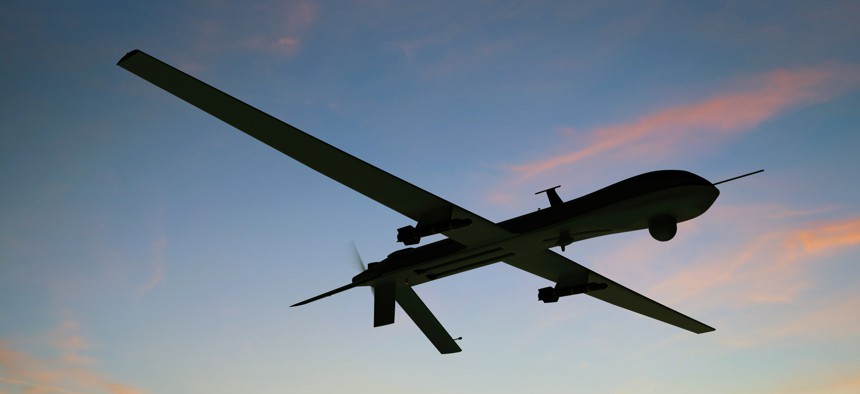sponsor content What's this?

Five Ways the Defense Industry Can Take Advantage of Emerging Technology
Technology advancement in the commercial market offers a glimpse into the future of defense.
Presented by
Accenture Federal Services

Due to the exponential growth of technology, the defense industry is evolving faster than ever. New tools, processes and strategies are emerging at a rapid pace. Technology advancement in the commercial market is a larger driver than ever, providing rapid innovation that defense organizations must harness in order to stay ahead of the curve. Increasingly, successful defense organizations are working closely with innovators to achieve success.
Each year, Accenture publishes its Technology Vision report, which offers a view into what the world will look like three short years from now. The trends covered in the report are opportunities for the defense industry to build on the latest technologies. Here’s how:
AI is the New UI
Artificial intelligence (AI) is tackling big and small problems by making interactions simpler and smarter. AI has become increasingly important for defense organizations as they struggle to process huge amounts of data and turn it into understandable and actionable information. This can be a lot of work for humans, but when AI does the processing, it can provide a first quick cut of analysis. The Pentagon, for example, is experimenting with automation and machine learning to analyze the massive amount of video collected by drones in Iraq and Afghanistan. This fast access to insights is key for decision-making and operational agility, because people can spend more time looking at the results, rather than struggling to produce them.
The rise of AI is influencing defense organizations in both planning and operations. For instance, mission systems have become more autonomous in air, ground, sea and space. The military is using unmanned vehicles to gather intelligence. There is great potential for AI in defense, especially as the technology continues to advance.
Design for Humans
Technology today is more intelligent, and it’s adapting to how we behave and learn. In defense, this type of design thinking needs to catch up. Weapons systems have become highly complex, and the interfaces to use them have become complicated. A human-centered user interface makes decision-making easier, and it can also accelerate reaction times.
Imagine if we could augment human capability to achieve an operational advantage? Training is one area that would benefit from machine learning. New research funded in part by the Army is putting this theory to the test, using brainwaves from trained and experienced soldiers to feed a neural network that analyzed targeting decisions. Eventually, such a network may be able to learn in real-time.
Ecosystem Power Plays
Platforms, the central hubs used to access and manage complex digital networks and the data within them, are completely changing the ways in which organizations operate and compete. Today, successful organizations are looking outside of their walls to work and integrate with partners on platforms for even the most core business functions. The defense industry should follow this lead and collaborate to secure innovation. For instance, working with industry, governmental organizations, academia and others will allow defense to tap into new skill-sets and thinking never before possible.
We are seeing platform thinking in an operational sense when organizations run on a “defense as a platform” type of scenario that involves other partners in the ecosystem. The aspiration for the Joint Information Environment is a single, joint, secure and agile command, control, communications and computing environment for Department of Defense agencies helping to protect against cyberattack.
Workforce Marketplace
On-demand labor platforms are surging, resulting in a collapse of traditional hierarchies. Defense can clearly benefit from access to on-demand resources. Think about the constant fluctuation in readiness requirements. Today’s level of mobilization might not be adequate tomorrow, or it might be too extensive next week. To continuously adapt, organizations must shift their pool of people resources, and also their cache of equipment. By adopting a new workforce marketplace model, where traditional hierarchies and bureaucracies are abandoned in favor of a more open structure, organizations can be more flexible to adapt and respond to an ever-evolving landscape.
These fluctuations come into play with technology as well. Defense IT systems must become better-equipped to scale up and scale down so that organizations may increase — or decrease — their posture intermittently.
The Uncharted
In today’s ecosystem-driven digital economy, there is still an abundance of uncharted territory. It is important to explore this new ground, but do so with the correct strategy. Defense organizations must also establish rules and standards along the way. For example, there are new, innovative ways in which defense organizations can share information and conduct operations using social media. But how is that data protected? How are we safeguarding intellectual property? What can we do to protect against cyber threats?
The organizations that are the quickest and smartest to enter this new ground and innovate will have the clear advantage. Indeed, through observation one can argue that organizations that are faster at innovation are in a better position than those that only focus on invention.
Learn more about how these trends are shaping the future in Accenture’s Technology Vision 2017 report.
NEXT STORY: Spirit AeroSystems: Where Flight Begins